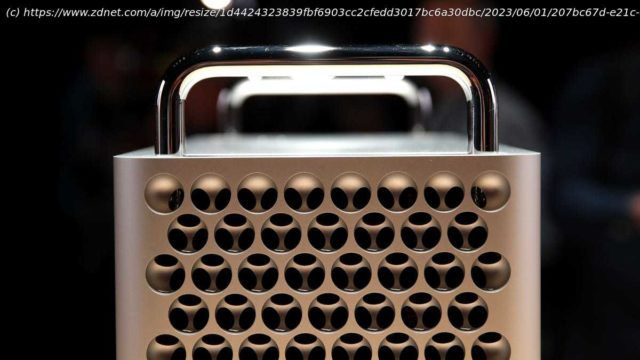Let’s explore what an Apple Silicon Mac Pro might be like, complete with a blade-based SOC bus.
With the Mac Studio filling in for a lot of the Mac Pro demand, and the somewhat inflexible architecture of the Apple Silicon chip sets, building a traditional, highly-flexible, bus-based Apple Silicon chip set seems impossible. With Apple expected to finally announce an Apple Silicon-based Mac Pro at WWDC 2023, we explore one way Apple might build a flexible Mac Pro on the Apple Silicon architecture.
What defines a Mac Pro? Certainly, its CPU power. We’ll come back to that, because even in the Intel days, a random tower with a Xeon processor was not a Mac Pro. There was always a little somethin‘-somethin‘ that made Mac Pros special.
Let’s for the moment leave out the circular 2013 Mac Pro „trash can“ incarnation. One of the reasons that the product failed to excite was because it didn’t really share true Mac Pro DNA.
Original „cheese grater“ Mac Pro
The first Mac Pro debuted in 2006 and introduced the immediately iconic cheese grater tower design. In addition to the style notes, the 2006 through 2012 cheese grater designs offered a lot of drive bays for expansion, a lot of bus slots for expansion, a ton of RAM capacity, and — in what would be a hallmark of the Mac Pro’s industrial design — mechanisms that made adding and removing those internal components smooth as butter.
The premise behind the Mac Pro was simple: you could configure it to do anything, make it as powerful as you needed, and expand it as much as you could imagine — and do so with grace and ease. That’s the Mac Pro’s DNA in a sentence.
No love was lost on this design.
That was also the failure of the 2013 Mac Pro. There were no slots. You couldn’t really upgrade the video cards. For six years, the 2013 Mac Pro was stuck, primarily because Apple abandoned the „configure it to do anything“ aspect of its DNA.
In 2019, Apple created an homage to the cheese grater Mac Pro. Expansion was back, as was Apple’s brilliant industrial design for adding and removing components. Apple even returned to the PCI Express bus, although by then, later generations of PCI Express had become substantially more capable than what was in the 2006 original model.
Note that when I talk about Mac Pro DNA, I’m not mentioning the price. In a sense, being brain-screamingly expensive seems like part of the Mac Pro DNA, but since many users are major film studios and labs, the price is not unreasonable. The key was that the Mac Pro removed the „what you can do with it“ capability ceiling of the Mac and made the sky the limit.
Since all the Mac Pros (except the anomalous trash can) have been so flexible and so expandable, it has been possible to upgrade the units over time, giving them a much longer usable life than they would have had if they hadn’t been expandable.
Let’s reiterate what makes the Mac Pro DNA unique: you can configure it to do anything, make it as powerful as you need, and expand it as much as you can imagine — and do so with grace and ease.
Two of those characteristics are in direct conflict with the Apple Silicon M-series architecture: configure it to do anything, and expand it as much as you can imagine.
Don’t deny it. You can see yourself grating some fine Tillamook cheddar on this, can’t you?
Apple Silicon (both M1 and M2) is a system-on-a-chip (or SOC). Everything of consequence is built inside the chip itself. It’s not just the CPU (or CPUs), it’s the RAM, the GPU(s), the neural processors — everything.
The M-series chips (whether the base model, the Pro, the Max, or the Ultra) don’t allow you to add RAM. What you buy is what’s on the silicon wafer. It doesn’t allow you to change out the GPU. Now, yes, the Pro, Max, and Ultra chips allow you to run a whole bunch of wholly capable internal GPUs, but you still don’t have any flexibility.
As far as we know, there’s no M-series bus architecture, since it’s all inside the chip.






